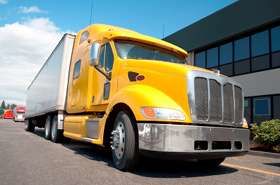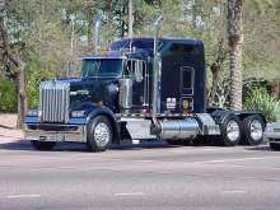Desperate For Help With Left Offset And Left Parallel - PLEASE HELP ME!
Topic 13851 | Page 1

You are asking about driver side offset? And a blind side parralle? Where are your tandoms set? Set up is everything if your set up is wrong it's a real struggle to the trailer todo what you want when you want it to.

Something that helped me was, with my initial setup having the end of my trailer lined up with the entrance to the parallel, turn wheel 1/2 a turn, (doesnt seem like enough, i know), as you start turning, keep an eye on your trailer landing gear! When you are nearing the 1/2 way point on your landing gear ( youll be watching for this in your mirrors, blindside will be in your small convex mirror, harder to see but concentrate on it) your trailer tandems should be crossing the line. Straighten up, and back in slowly, as your trailer tandems reach midway in the box, countersteer all the way back, once your tractor tandems reach almost 1/2 way in the box, countersteer quickly in opposite direction. Then just slowly walk it all in. I know this may sound complicated but if you set your reference points that should help a lot. Good luck, and while doing these practices remember the path your tires are making. Another thing that may help is once the tractor trailer is in the parallel box , pull it out and see observe how your turning to get it out. Its just theopposite to backing in then. Also , your offsets are basically the same paths as parallel, you just have more room to manuever. You always want to have tractor-trailer straight and see both cones to the entrances in your mirrors, then its basically a straight line back with a little angle in it. Wow, im sure ive made this sound hard, but its not, just keep track of what ur doing and correct it. Good luck :)
Tandems:
Tandem Axles
A set of axles spaced close together, legally defined as more than 40 and less than 96 inches apart by the USDOT. Drivers tend to refer to the tandem axles on their trailer as just "tandems". You might hear a driver say, "I'm 400 pounds overweight on my tandems", referring to his trailer tandems, not his tractor tandems. Tractor tandems are generally just referred to as "drives" which is short for "drive axles".
Tandem:
Tandem Axles
A set of axles spaced close together, legally defined as more than 40 and less than 96 inches apart by the USDOT. Drivers tend to refer to the tandem axles on their trailer as just "tandems". You might hear a driver say, "I'm 400 pounds overweight on my tandems", referring to his trailer tandems, not his tractor tandems. Tractor tandems are generally just referred to as "drives" which is short for "drive axles".

So, basically what I'm gathering. you're having a hard time getting the trailer to go where you want it to go. I'm not exactly qualified to offer advice on issues in the civilian sector, but I drove tractor-trailers in the army for 8 years. One thing I learned was to Jack and chase. When you begin your maneuver, you want the rear of the trailer to got to the right or the left. To accomplish this, you only want to make minimal adjustments to your steering wheel, too much and you'll end up jack knifing. While you are backing up, you want to watch the sides of your trailer and not the tandems. I don't know why, but it seems to make it easier , for me at least to get the trailer where you want it to go. As soon as you got the trailer in the right direction, get the tractor behind it immediately, make small adjustments and chase the trailer. I'm currently sitting in the hotel room awaiting Monday to get here, to begin my orientation with Roehl Transport. So I'm sitting here trying to get as much info as possible. if there is anything I can help with, please let me know.
Tandems:
Tandem Axles
A set of axles spaced close together, legally defined as more than 40 and less than 96 inches apart by the USDOT. Drivers tend to refer to the tandem axles on their trailer as just "tandems". You might hear a driver say, "I'm 400 pounds overweight on my tandems", referring to his trailer tandems, not his tractor tandems. Tractor tandems are generally just referred to as "drives" which is short for "drive axles".
Tandem:
Tandem Axles
A set of axles spaced close together, legally defined as more than 40 and less than 96 inches apart by the USDOT. Drivers tend to refer to the tandem axles on their trailer as just "tandems". You might hear a driver say, "I'm 400 pounds overweight on my tandems", referring to his trailer tandems, not his tractor tandems. Tractor tandems are generally just referred to as "drives" which is short for "drive axles".
Annee,, what you are doing is a classic rookie mistake, don't let it frustrate you excessively, we've all had to learn this backing thing and it is tricky to say the least. You are way over-steering. Now, my advice may not be that much help to you because i never liked those formulas they teach at trucking schools, like hold the wheel turned all the way and count to three and then turn it back the other way, or hold it until you see the center of the landing gear! All that stuff was worthless to me, because it was a short-cut "Jack-leg" way to teach folks to be able to pass the test but it did nothing to prepare them for the real world of parking a truck.
Listen, if you can get it down well enough to pass the test, then hooray for you, but after you get on a trainer's truck ask them to let you practice in an almost empty parking lot at a truck stop. I did this a lot when I first had my own truck. I would set aside some time in the middle of the day when the truck stops were almost empty and practice backing in between the lines. The thing that helped me the most was to watch where my tandems (the wheels on the trailer) were rolling. That showed me exactly where the trailer was going because the trailer went where the wheels were going! Learn to "feel" the relationship between the input you are giving at the steering wheel and how those trailer wheels respond to it. Beware... the response from the wheels is sloooow! That is why you are over-steering... you expect the trailer to be doing what you want, and when it doesn't do it just right you just keep on turning that wheel, and then the next thing you know you are jack-knifed in the total wrong direction of what you were trying to accomplish.
Turn the wheel a little and then let that truck roll for about eight feet... watch what is happening by viewing where those wheels are rolling. If you need them to move over a little more then turn the wheel a little bit more and wait as it rolls along. Less is more - try to remember that little saying when you are turning the wheel in reverse.
Tandems:
Tandem Axles
A set of axles spaced close together, legally defined as more than 40 and less than 96 inches apart by the USDOT. Drivers tend to refer to the tandem axles on their trailer as just "tandems". You might hear a driver say, "I'm 400 pounds overweight on my tandems", referring to his trailer tandems, not his tractor tandems. Tractor tandems are generally just referred to as "drives" which is short for "drive axles".
Tandem:
Tandem Axles
A set of axles spaced close together, legally defined as more than 40 and less than 96 inches apart by the USDOT. Drivers tend to refer to the tandem axles on their trailer as just "tandems". You might hear a driver say, "I'm 400 pounds overweight on my tandems", referring to his trailer tandems, not his tractor tandems. Tractor tandems are generally just referred to as "drives" which is short for "drive axles".
HOS:
Hours Of Service
HOS refers to the logbook hours of service regulations.Annee, here's a real life observation. This won't necessarily help you now, but it's a view over the hill.
There are truck rest areas genuinely designed for trucks to parallel park. (They don't make them like that any more.) What I've seen there is trucks will pull forward into the curb area. No one does a true parallel park job. You may get into a parallel park situation but they are rare.

Annee,, what you are doing is a classic rookie mistake, don't let it frustrate you excessively, we've all had to learn this backing thing and it is tricky to say the least. You are way over-steering. Now, my advice may not be that much help to you because i never liked those formulas they teach at trucking schools, like hold the wheel turned all the way and count to three and then turn it back the other way, or hold it until you see the center of the landing gear! All that stuff was worthless to me, because it was a short-cut "Jack-leg" way to teach folks to be able to pass the test but it did nothing to prepare them for the real world of parking a truck.
Listen, if you can get it down well enough to pass the test, then hooray for you, but after you get on a trainer's truck ask them to let you practice in an almost empty parking lot at a truck stop. I did this a lot when I first had my own truck. I would set aside some time in the middle of the day when the truck stops were almost empty and practice backing in between the lines. The thing that helped me the most was to watch where my tandems (the wheels on the trailer) were rolling. That showed me exactly where the trailer was going because the trailer went where the wheels were going! Learn to "feel" the relationship between the input you are giving at the steering wheel and how those trailer wheels respond to it. Beware... the response from the wheels is sloooow! That is why you are over-steering... you expect the trailer to be doing what you want, and when it doesn't do it just right you just keep on turning that wheel, and then the next thing you know you are jack-knifed in the total wrong direction of what you were trying to accomplish.
Turn the wheel a little and then let that truck roll for about eight feet... watch what is happening by viewing where those wheels are rolling. If you need them to move over a little more then turn the wheel a little bit more and wait as it rolls along. Less is more - try to remember that little saying when you up turning the wheel in reverse.
Thank you Old School, this helped a lot. I had 4 turns with the skills course today and the first 3 turned out good, the last one I kind of messed up. But I did it - Yea!! I appreciate you taking the time to help.
Tandems:
Tandem Axles
A set of axles spaced close together, legally defined as more than 40 and less than 96 inches apart by the USDOT. Drivers tend to refer to the tandem axles on their trailer as just "tandems". You might hear a driver say, "I'm 400 pounds overweight on my tandems", referring to his trailer tandems, not his tractor tandems. Tractor tandems are generally just referred to as "drives" which is short for "drive axles".
Tandem:
Tandem Axles
A set of axles spaced close together, legally defined as more than 40 and less than 96 inches apart by the USDOT. Drivers tend to refer to the tandem axles on their trailer as just "tandems". You might hear a driver say, "I'm 400 pounds overweight on my tandems", referring to his trailer tandems, not his tractor tandems. Tractor tandems are generally just referred to as "drives" which is short for "drive axles".
HOS:
Hours Of Service
HOS refers to the logbook hours of service regulations.
Hi all you wonderful helpful truckers here on my favorite trucking website.
I'm scheduled to test in about 10 days and I still can't offset or parallel park. I get the concept and others make it look so easy but once I get in the truck I lose it. I have the first part down but turning and straightening up in the boxes isn't working for me. This is killing my confidence and although I have the pre trip and driving down, I'm beginning to feel kind of stupid. Why can't I get this?
I turn the wheel all the way to the right, count out to 3 and turn the wheel to the left and then straighten out - this part I'm fine with. My problem seems to be getting into the boxes correctly. I have even jackknifed trying to parallel. Are there marking points I should use to know when to turn? Can anyone give me step by step instructions? You guys (and gals) have helped me (even though you don't know it) with so many parts of this process up till now, I'm hoping you can help me again.
Thank you once again for any advice you can offer. Annee
I did it today - not once, but 3 times!!! I want to thank all you guys for your advise - It absolutely helped. This website, and all the information and knowledge shared by all you experienced drivers, has gotten me through this sometimes difficult process. I say this in all seriousness: I don't believe I would have made it through without it. I know I'm not through yet, but I'm very close - so thank you again - you people rock!!!!!! Annee

Annee, here's a real life observation. This won't necessarily help you now, but it's a view over the hill.
There are truck rest areas genuinely designed for trucks to parallel park. (They don't make them like that any more.) What I've seen there is trucks will pull forward into the curb area. No one does a true parallel park job. You may get into a parallel park situation but they are rare.
Thank you Errol, that's a good idea and I plan on doing just that.
Hang in there Annee!
There will be many more challenges to come - ChickieMonster said it best the other day in one of her comments - here it is:
Bottom line: I love my job! I have questioned whether or not I was going to like this. But now that I'm here really doing it, it's the coolest, most incredible and hardest thing I've ever done in my life!
It is both the "coolest" thing and the "hardest" thing she has ever done. I like the way she put that, and I think you will have the same thoughts and experience as you progress along.
Keep it up - You Can Do This!
New Reply:
New! Check out our help videos for a better understanding of our forum features

















Preview:








 TT On Facebook
TT On Facebook
Hi all you wonderful helpful truckers here on my favorite trucking website.
I'm scheduled to test in about 10 days and I still can't offset or parallel park. I get the concept and others make it look so easy but once I get in the truck I lose it. I have the first part down but turning and straightening up in the boxes isn't working for me. This is killing my confidence and although I have the pre trip and driving down, I'm beginning to feel kind of stupid. Why can't I get this?
I turn the wheel all the way to the right, count out to 3 and turn the wheel to the left and then straighten out - this part I'm fine with. My problem seems to be getting into the boxes correctly. I have even jackknifed trying to parallel. Are there marking points I should use to know when to turn? Can anyone give me step by step instructions? You guys (and gals) have helped me (even though you don't know it) with so many parts of this process up till now, I'm hoping you can help me again.
Thank you once again for any advice you can offer. Annee